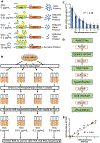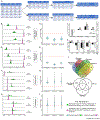Genome-wide gene expression responses to experimental manipulation of Saccharomyces cerevisiae repressor activator protein 1 (Rap1) expression level
- PMID: 37068644
- PMCID: PMC10351348
- DOI: 10.1016/j.ygeno.2023.110625
Genome-wide gene expression responses to experimental manipulation of Saccharomyces cerevisiae repressor activator protein 1 (Rap1) expression level
Abstract
Precise regulation of transcription in gene expression is critical for all aspects of normal organism form, fitness, and function and even minor alterations in the level, location, and timing of gene expression can result in phenotypic variation within and between species including evolutionary innovations and human disease states. Eukaryotic transcription is regulated by a complex interplay of multiple factors working both at a physical and molecular levels influencing this process. In Saccharomyces cerevisiae, the TF with the greatest number of putative regulatory targets is the essential gene Repressor Activator Protein 1 (RAP1). While much is known about the roles of Rap1 in gene regulation and numerous cellular processes, the response of Rap1 target genes to systematic titration of RAP1 expression level remains unknown. To fill this knowledge gap, we used a strain with a tetracycline-titratable promoter replacing wild-type regulatory sequences of RAP1 to systematically reduce the expression level of RAP1 and followed this with RNA sequencing (RNA-seq) to measure genome-wide gene expression responses. Previous research indicated that Rap1 plays a significant regulatory role in particular groups of genes including telomere-proximal genes, homothallic mating (HM) loci, glycolytic genes, DNA repair genes, and ribosomal protein genes; therefore, we focused our analyses on these groups and downstream targets to determine how they respond to reductions in RAP1 expression level. Overall, despite being known as both an activator and as a repressor of its target genes, we found that Rap1 acts as an activator for more target genes than as a repressor. Additionally, we found that Rap1 functions as an activator of ribosomal protein genes and a repressor for HM loci genes consistent with predictions from the literature. Unexpectedly, we found that Rap1 functions as a repressor of glycolytic enzyme genes contrary to prior reports of it having the opposite effect. We also compared the expression of RAP1 to five different genes related to DNA repair pathway and found that decreasing RAP1 downregulated four of those five genes. Finally, we found no effect of RAP1 depletion on telomere-proximal genes despite its functioning to silence telomeric repeat-containing RNAs. Together our results enrich our understanding of this important transcriptional regulator.
Keywords: Bootstrapping; Gene expression; RNA-Seq; Rap1; Saccharomyces cerevisiae; Transcription factor.
Copyright © 2023 The Authors. Published by Elsevier Inc. All rights reserved.
Conflict of interest statement
Declaration of Competing Interest The authors declare no conflicts of interest.
Figures



References
Publication types
MeSH terms
Substances
Grants and funding
LinkOut - more resources
Full Text Sources
Molecular Biology Databases
Research Materials
Miscellaneous

